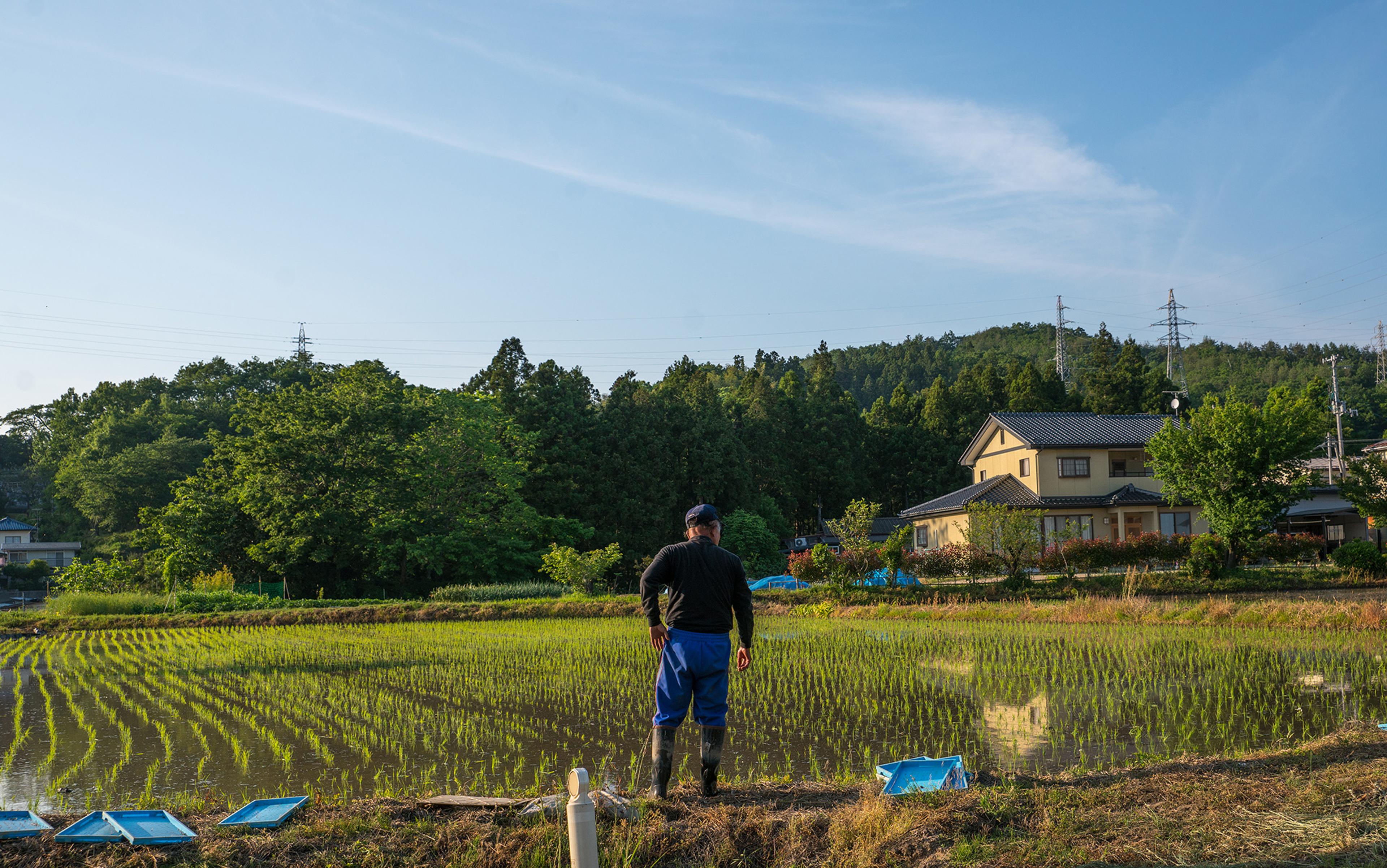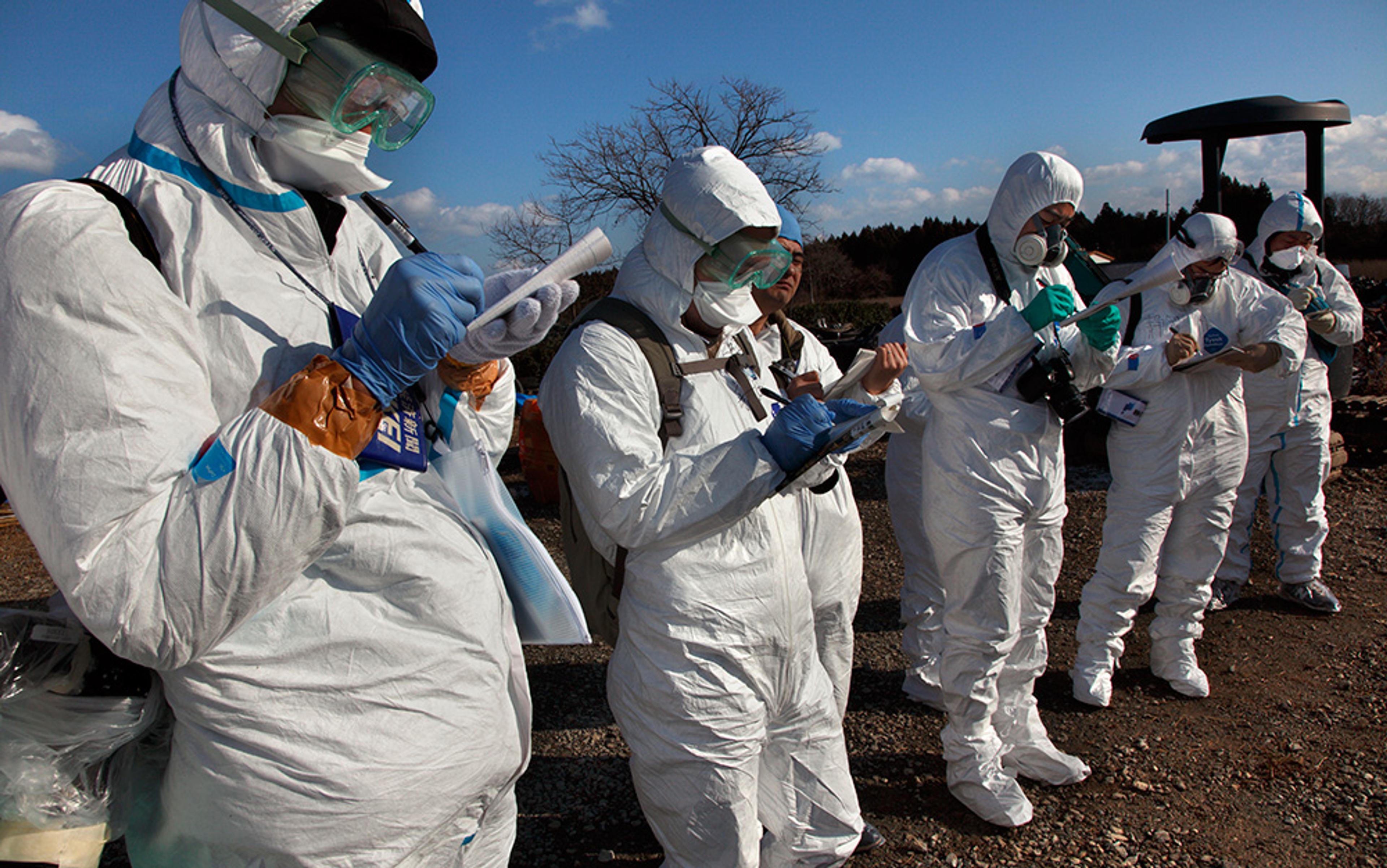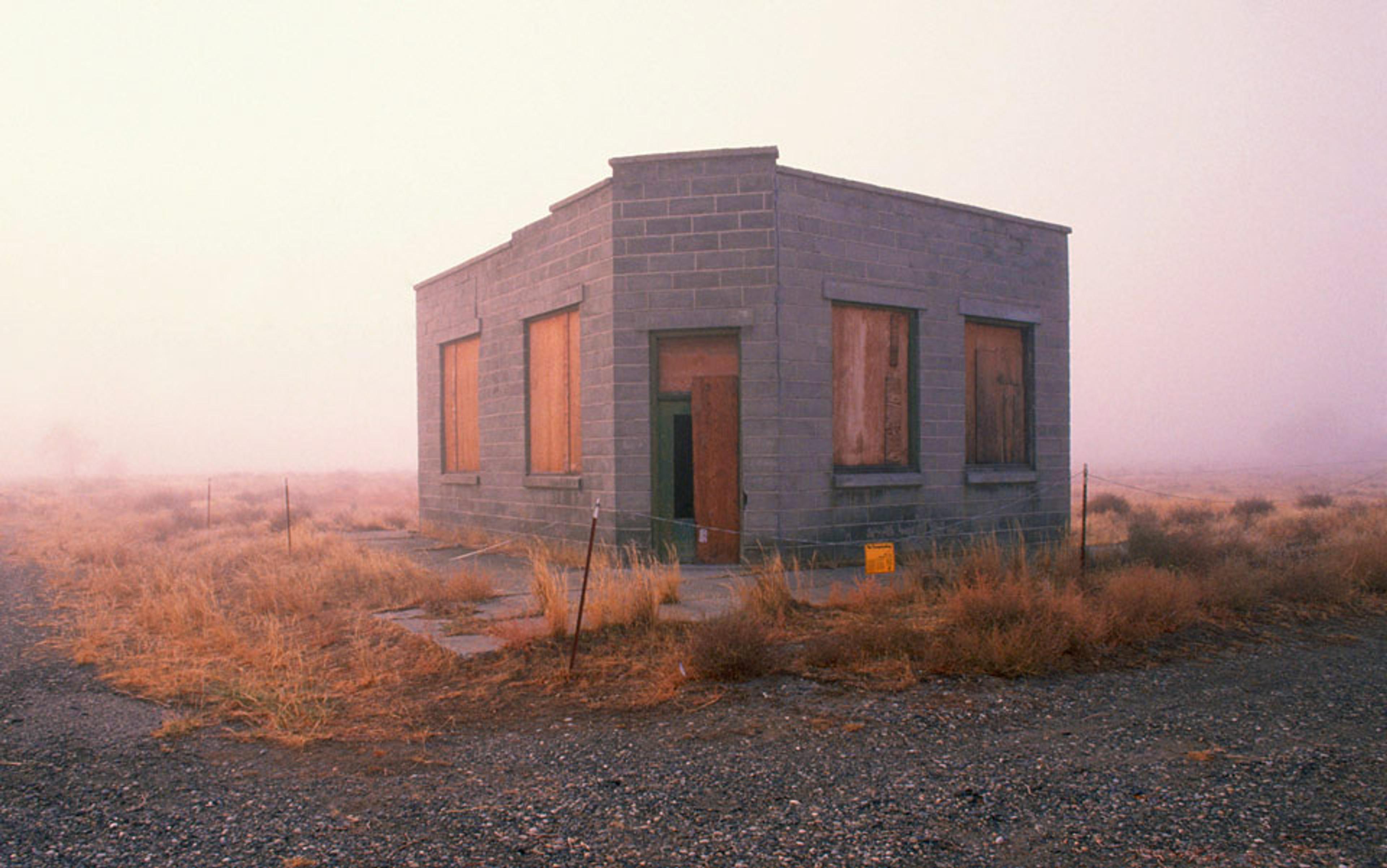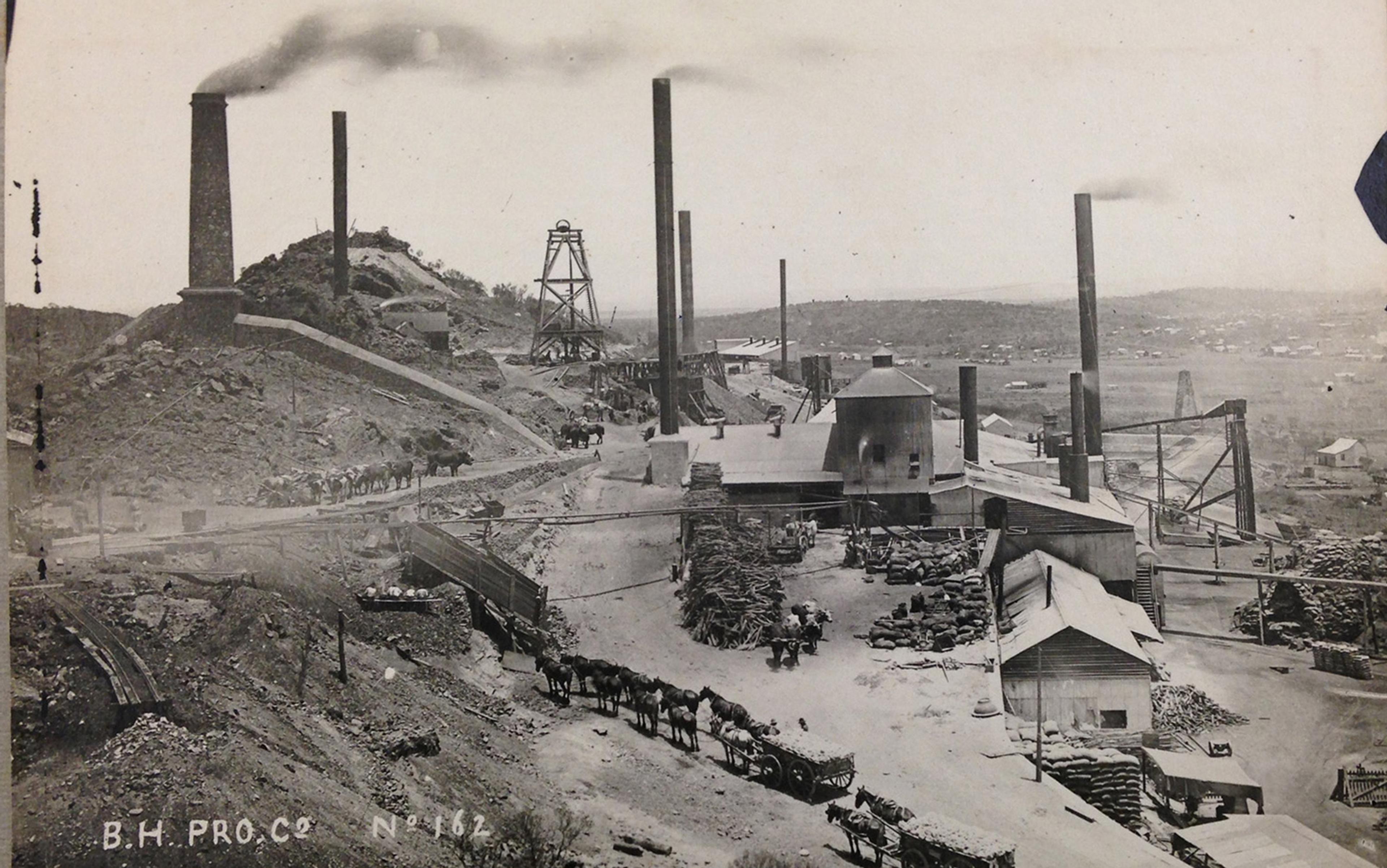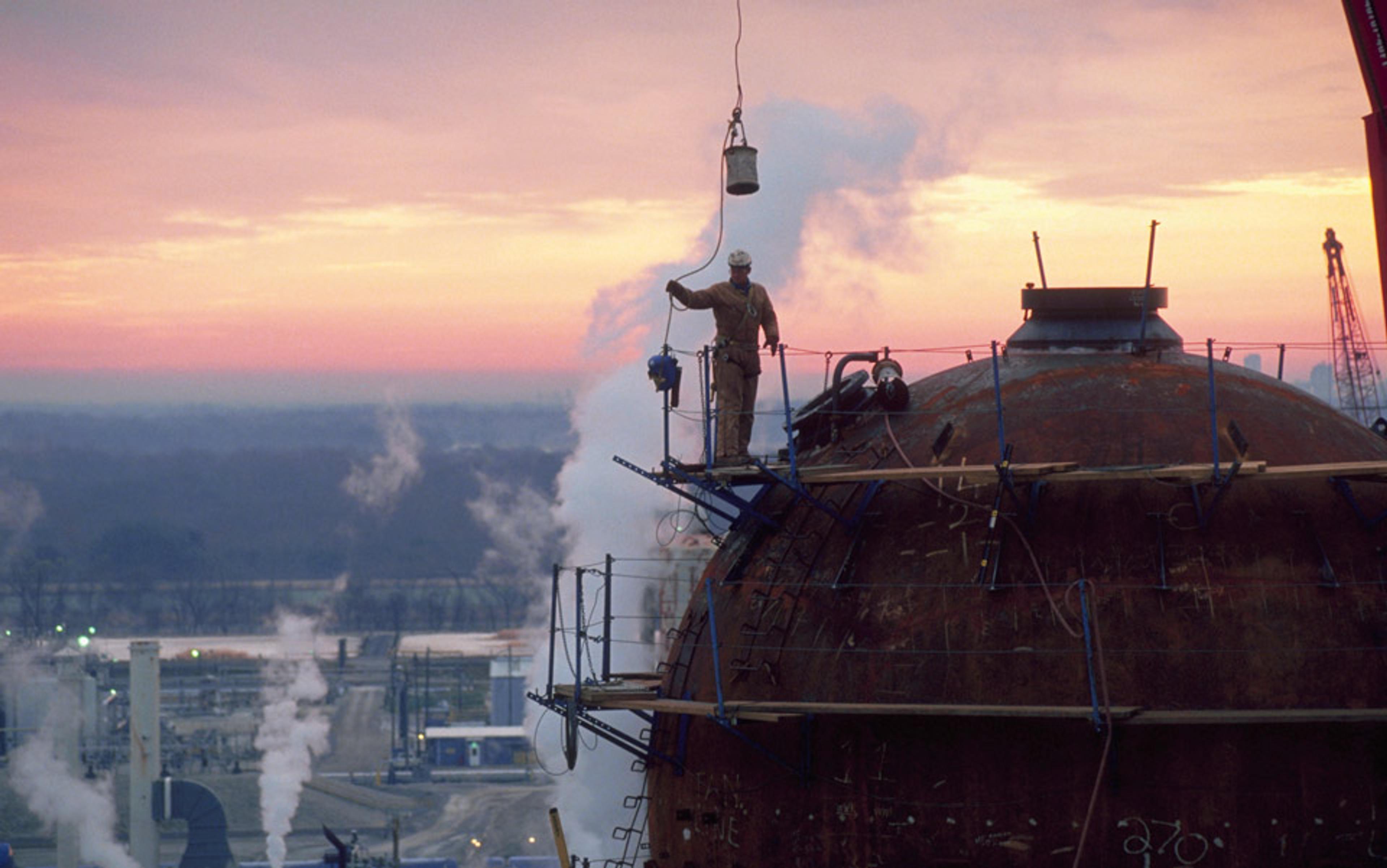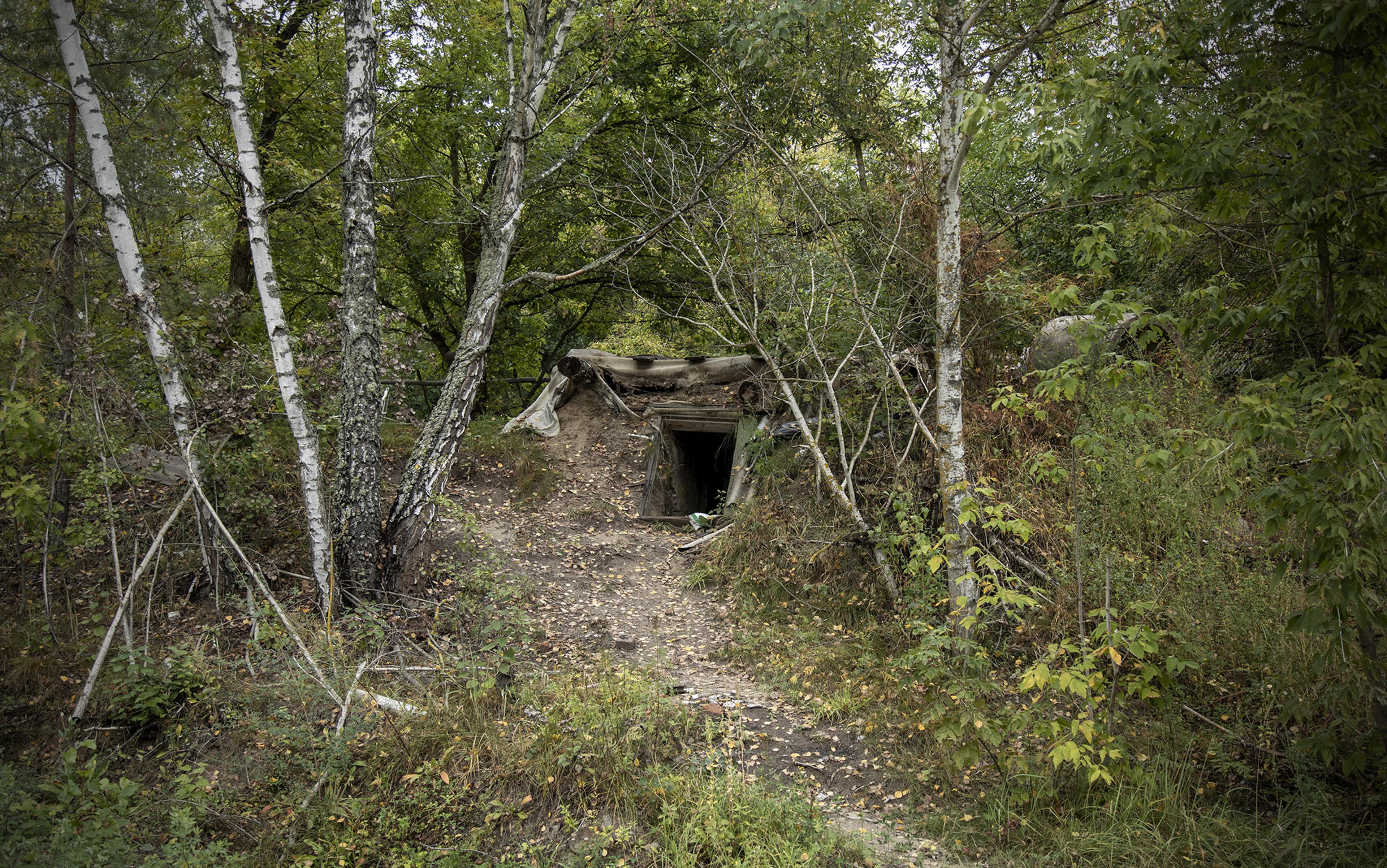As a farmer, Atsuo Tanizaki did not care much for the state’s maps of radioactive contamination. Colour-coded zoning restrictions might make sense for government workers, he told me, but ‘real’ people did not experience their environment through shades of red, orange and green. Instead, they navigated the landscape one field, one tree, one measurement at a time. ‘Case by case,’ he said, grimly, as he guided me along the narrow paths that separated his rice fields, on the outskirts of a small village in Japan’s Fukushima prefecture.
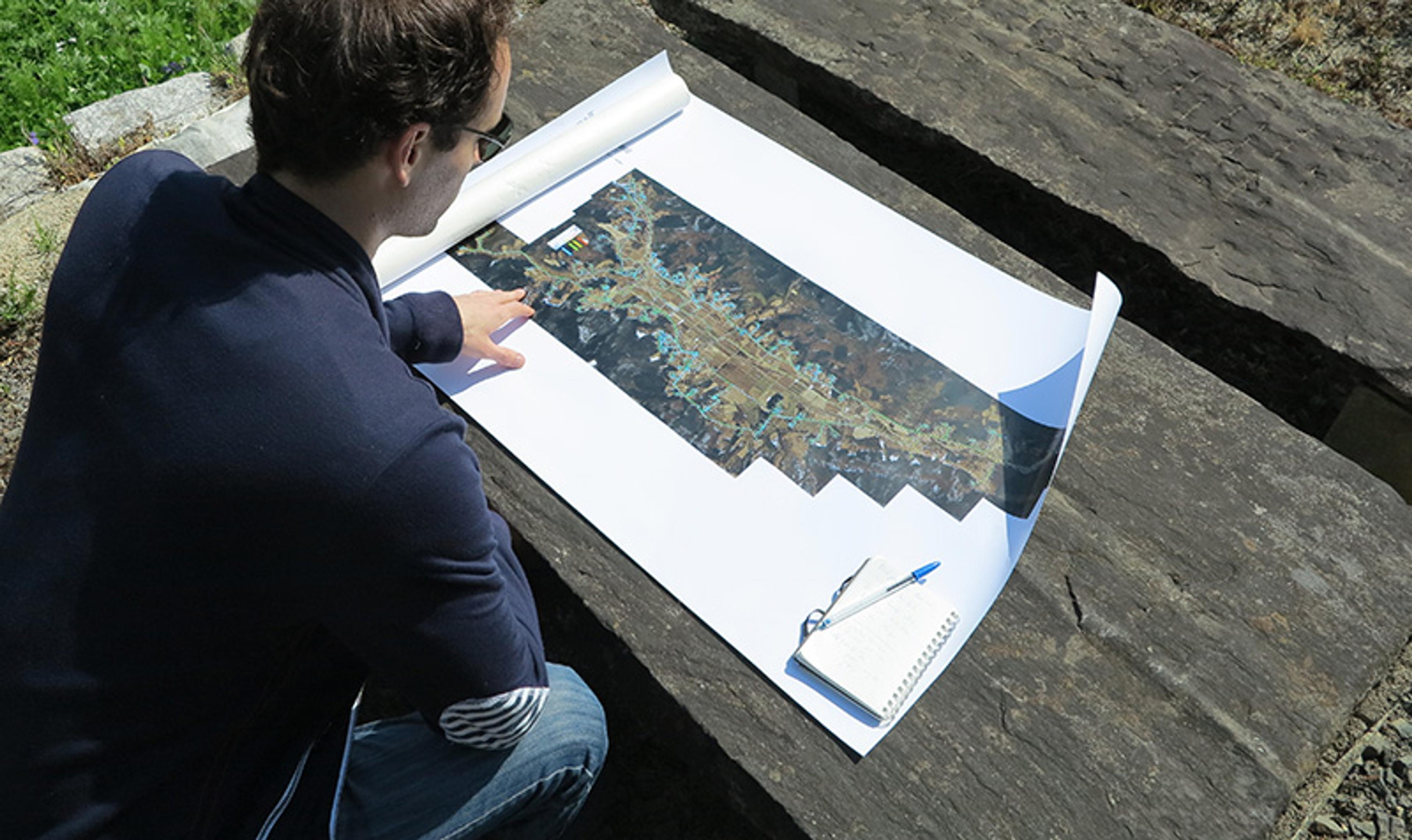
The author examines maps of radioactive contamination in Fukushima. Photo supplied by the author
It was spring in 2016 when I first visited Tanizaki’s farm. The air was warm. The nearby mountains were thick with emerald forests of Japanese cedar, konara oak and hinoki cypress. A troop of wild red-faced monkeys stopped foraging to watch us as we walked by. And woven through it all – air, water, land, plants, and living bodies – were unseen radioactive pollutants. Almost everything now carried invisible traces of the 2011 meltdown at the Fukushima Daiichi nuclear power plant.
Tanizaki began taking measurements. With his Geiger counter, he showed me how radioactive elements were indifferent to the cartographic logic of the state. In some places, the radiation level dropped low, becoming almost insignificant. But here and there, beside a ditch or near a pond, the level was elevated dangerously high. Tanizaki called these areas ‘hot spots’ and they were scattered across the landscape, even within supposedly ‘safe’ zones on government maps. Contamination in Fukushima, he believed, was structured in a way that no state was prepared to solve.
A decade after the 2011 meltdown, the region remains contaminated by industrial pollution. Though attempts at removing pollutants continue, a new realisation has taken hold among many of Fukushima’s farmers: there’s no going back to an uncontaminated way of life.
Watching Tanizaki measuring industrial pollution in a toxic landscape neglected by the state, I began to wonder: is this a future that awaits us all?
As an anthropologist interested in contamination, Fukushima throws into sharp relief the question of what it means to live in a permanently polluted world. That is why I began coming to Japan, and spending time with farmers such as Tanizaki. I wanted to understand the social dynamics of this new world: to understand how radioactivity is governed after a nuclear disaster, and how different groups clash and collaborate as they attempt to navigate the road to recovery.
I expected to find social bonds pushed to breaking point. Stories of post-disaster collapse circulate in our collective consciousness – tales of mistrust, fear and isolation, accompanied by images of abandoned homes and towns reclaimed by plants and wildlife. And I found plenty of that. A sense of unravelling has indeed taken hold in rural Fukushima. Residents remain uncertain about the adverse health effects of living in the region. Village life has been transformed by forced evacuations and ongoing relocations. And state-sponsored attempts at revitalisation have been ineffective, or complete failures. Many communities remain fragmented. Some villages are still abandoned.
Farmers took matters into their own hands, embracing novel practices for living with toxic pollution
In Fukushima, I found a society collapsing under the weight of industrial pollution. But that’s only part of the story. I also found toxic solidarity.
Rather than giving up, Tanizaki and other farmers have taken matters into their own hands, embracing novel practices for living alongside toxic pollution. These practices go far beyond traditional ‘farming’. They involve weaving relationships with scientists, starting independent decontamination experiments, piloting projects to create food security, and developing new ways to monitor a changing environment. Among rice fields, orchards and flower beds, novel modes of social organisation are emerging – new ways of living from a future we will one day all reckon with.
But the story of toxic solidarity in Fukushima doesn’t begin among rice fields and farms. It begins under the Pacific Ocean, at 2:46pm on 11 March 2011. At that moment, a magnitude 9.0-9.1 earthquake off the coast of northeastern Japan caused a devastating tsunami that set in motion a chain of events leading to the meltdown of three reactors at the Fukushima Daiichi nuclear power plant. Soon, Fukushima would find its place alongside Three Mile Island and Chernobyl as an icon of nuclear disaster – and an emblem of the Anthropocene, the period when human activity has become the dominant influence on environmental change. As the reactors began to meltdown, pressure mounted in the power station’s facilities, leading to explosions that released dangerous radionuclides into the air, including caesium-134, caesium-137, strontium-90 and iodine-131. These isotopes, with lifespans ranging from days to centuries, blew across Fukushima and northeastern Japan. And as they accumulated, health risks increased – risks of cancers and ailments affecting the immune system. To protect the population, the Japanese state forced tens of thousands of citizens living near the reactors to evacuate.
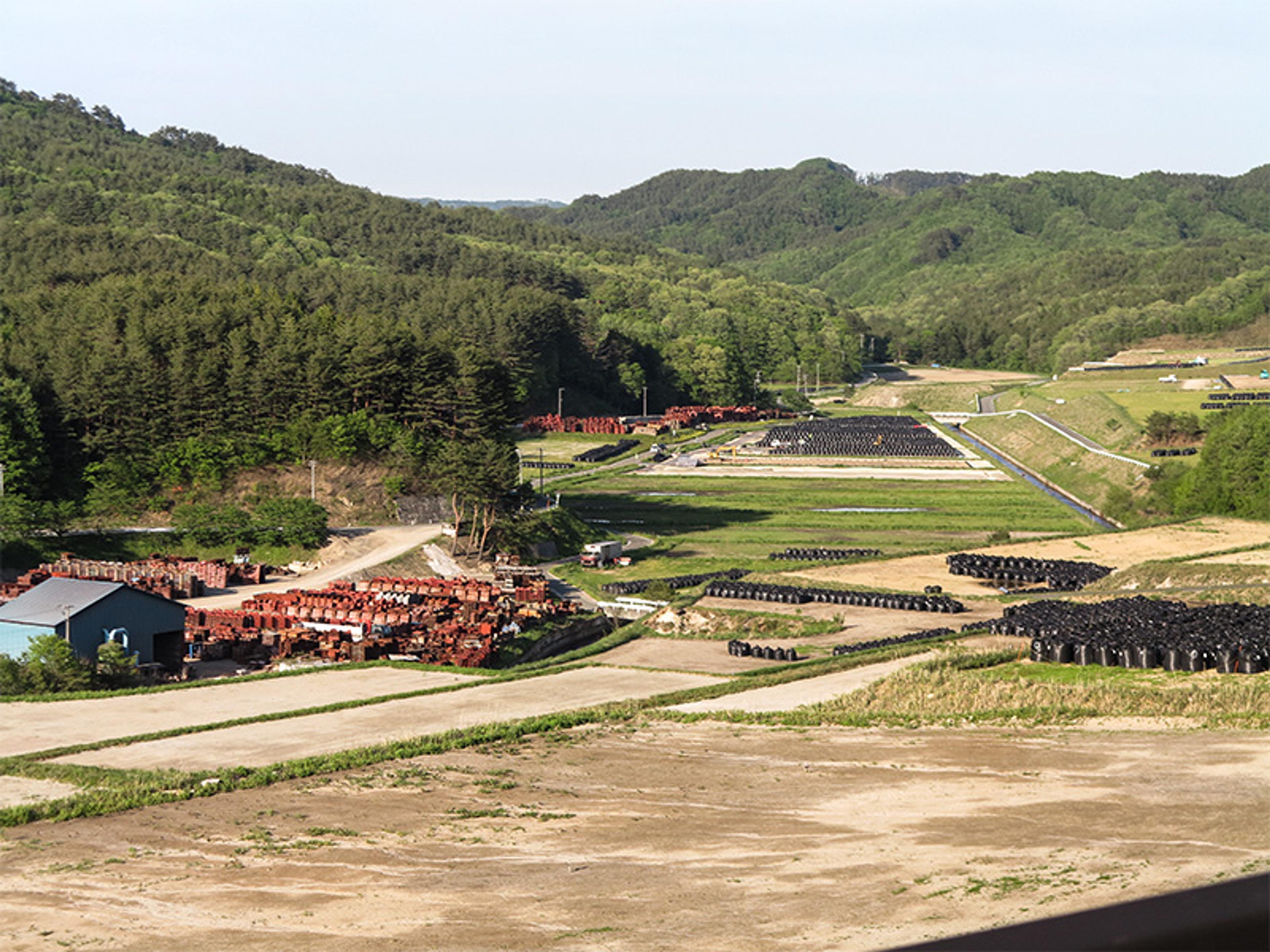
Furekonbaggu, bags of contaminated soil, piled neatly in the Fukushima countryside. Photo supplied by the author
At first, Tanizaki believed he had escaped the worst of the radiation because his village was not in the mandatory evacuation area. But when the wind carried radionuclides – invisible, tasteless, odourless – far beyond the government models, his village became one of the most contaminated areas in Fukushima. He learned he had been exposed to harmful radiation only when the government forced him to leave.
Tanizaki and other evacuated villagers were relocated to ‘temporary’ housing. As the months became years, Tanizaki longed to return to his life as a farmer. But what would he farm? His land had been irradiated, and no one wanted to eat food grown in radioactive topsoil. To help Fukushima’s rural citizens retrieve their farms, the Japanese government launched an official politics of revitalisation in Fukushima, investing trillions of yen to clean and decontaminate the region before repatriating evacuees. Part of the cleanup involved storing tainted topsoil in large black plastic bags known as furekonbaggu (literally ‘flexible container bags’), which were then stacked in piles throughout the countryside. To keep residents safe, the government also promised to track contamination through a monitoring system. At the time, the possibility of a pristine Fukushima seemed within reach.
In June 2015, after four years of forced evacuation, Tanizaki was finally allowed to return to his farm. But the decontamination efforts had failed. He and many others felt they had been returned to a region abandoned by the government. The landscape was now covered in millions of bags of radioactive topsoil – black pyramids of the Anthropocene – while the government waited for a permanent disposal site. Also, the plastic in some furekonbaggu had already broken down, spilling radioactive soil over freshly decontaminated land. The state’s monitoring efforts were equally inadequate. In Tanizaki’s village, the monitoring of airborne radiation produced measurements that were rarely precise enough to give a complete picture of shifting contamination. Villagers lived with constant uncertainty: is the garden contaminated? Are the trees behind the house safe? Are mushrooms in the forest still edible?
I saw dead sunflowers rooted in irradiated fields – withered emblems of dreams to retrieve Fukushima
For some, the uncertainty was too much. Tens of thousands relocated to other parts of Japan rather than returning. In 2010, the region registered 82,000 people whose main income came from farming. But by 2020, that number had fallen to around 50,000. Abandoned greenhouses and fields can still be found dotted across the landscape.

Withered sunflowers in irradiated fields. Photo supplied by the author
Knowing that government efforts weren’t going to help, some returnees began to decontaminate their own villages and farms. There was hope that the region could be returned to its former uncontaminated glory. One proposed method involved planting sunflowers, which were believed to absorb radiation as they grew. Yellow flowers bloomed across the farmlands of Fukushima. However, the results were unsatisfactory. Even during my time in Japan, years after the disaster, I saw dead sunflowers still rooted in irradiated fields – withered emblems of early dreams to retrieve a pre-disaster Fukushima. I also witnessed decontamination experiments in rice paddies: farmers would flood their fields, and then use tools to mix the water with the irradiated topsoil below, stirring up and dislodging radioactive pollutants such as caesium. The muddy water was then pushed out of the field using large stiff-bristled brushes. This project also failed. Some paddy fields are still so contaminated they can’t grow rice that’s safe for human consumption.
These failures significantly affected the morale of Fukushima’s farmers, especially considering the importance of the region as a rice-growing capital. Once easy decontamination efforts failed, returnees were forced to ask themselves difficult questions about their homes, livelihoods and identities: what will happen if farming is impossible? What does it mean to be a rice farmer when you can’t grow rice? What if life has been irrevocably altered?
Even the mushrooms tasted different. One farmer, Takeshi Mito, told me he had learned to grow shiitake mushrooms on artificial tree trunks, since real trees were too contaminated to produce edible fungi. ‘Now the taste of the shiitake has changed,’ he mumbled, a strange sadness filling his voice. The ‘real’ trees had given the mushrooms a special flavour, just like ageing a whisky in a sherry cask. ‘Yeah,’ he said, pausing to remember. ‘They were good.’
A new reality was emerging. Farmers were learning to accept that life in Fukushima would never be the same. Small details are constant reminders of that transformation, like the taste of mushrooms, or the library in Tanizaki’s home, which is now filled with books on Chernobyl, nuclear power, radioactive contamination, and food safety. This is new terrain, in which everyone carries a monitoring device, and in which everyone must learn to live with contamination. A former way of life may be impossible to retrieve, and attempts at decontamination may have failed, but farmers such as Tanizaki are learning to form new relationships to their irradiated environment. They’re forging new communities, reshaping notions of recovery, and reimagining their shared identities and values. Contamination may appear to have divided Fukushima’s farmers, but it has also united them in strange and unexpected ways.
By the time the evacuees were allowed to return to their homes, government mistrust had become widespread. Official promises were made to Fukushima residents that a nuclear disaster was impossible. These promises were spectacularly broken when radiation spread across the region. A lack of information from state sources made things only worse, leading to a growing sense that the government was unable to provide any real solutions. Not trusting state scientists, but still wanting to know more about the invisible harm in their villages, farmers reached out to academics, nongovernmental organisations and independent scientists in the hope of better understanding radioactivity.
These new relationships quickly changed social life in rural communities, and brought an influx of radiation monitoring devices. Rather than asking for additional state resources (or waiting endlessly for official responses to questions), farmers worked with their new networks to track radiation, measuring roads, houses, crop fields, forest areas and wildlife. Everyone learned to use radiation monitoring devices, which quickly became essential bodily extensions to navigate a changed Fukushima. Many rural communities even began to use them to develop their own maps. I remember the walls of Tanizaki’s home being covered in printed images showing the topography of the local landscape, with up-to-date information about radiation often provided by farmers. Local knowledge of the environment, combined with the technical savoir faire of independent scientists, produced far more accurate representations of contamination than the state maps made by government experts.
Sharing the work of living with contamination provided a feeling of communal life that returnees had so missed
Thanks to these maps, Tanizaki now knew that radiation doses were higher at the bottom of a slope or in ditches (where radionuclides could accumulate, forming ‘hot spots’). He also knew that the trees outside someone’s home increased the radiation levels inside. Through this mapping work, many farmers developed a kind of tacit knowledge of radiation, intuitively understanding how it moved through the landscape. In some cases, it moved far beyond the colour-coded zones around the reactors, or even the boundaries of Fukushima itself. A major culprit of this spread has been inoshishi (wild boar), who eat contaminated mushrooms before migrating outside irradiated areas, where their highly contaminated flesh can be eaten by unsuspecting hunters. To address this problem, monitoring programmes were developed based on the knowledge of farmers, who were familiar with the feeding and migration patterns of wild boar. Once a delicacy, inoshishi have become what the anthropologist Joseph Masco calls ‘environmental sentinels’: a new way to visualise and track an invisible harm.
But monitoring is more than a pragmatic tool for avoiding harm. In many instances, it also became a means of forging new communities. After returning, farmers began to share their knowledge and data with scientists, gathering to talk about areas that need to be avoided, or holding workshops on radiation remediation. Ironically, sharing the work of living with contamination provided a feeling of communal life that returnees had so missed. Ionising radiation can ‘cut’ the chemical bonds of a cell. Based on the experiences of Tanizaki and other farmers, it can also create novel connections.
Many farmers told me of their amazement at the sheer diversity of people who had come to support the revitalisation efforts. And it wasn’t only former evacuees who were drawn into these new communities. It was also the volunteers who came to help from other parts of Japan. One scientist I spoke with, who specialised in radiation monitoring, ended up permanently moving to a village in Fukushima, which he now considers his hometown. There are many similar cases, and they’re especially welcome in the aftermath of a disaster that has deeply fragmented Fukushima’s rural community. Some farmers told me there were times when they would go weeks without speaking to anyone. Life in a polluted, post-disaster landscape can be lonely.
Monitoring might have helped residents avoid harmful radiation, but it didn’t necessarily help with farming. Often, the new maps revealed that crops grown in certain areas would fall beyond the official permissible thresholds for radiation in food. And so, farmers who could no longer farm were forced to develop alternatives. In collaboration with university scientists, some former rice farmers began growing silver grass as a potential source of biofuel that would provide energy for their region. ‘If we can’t grow food, we can at least make energy!’ one scientist told me.

Photo supplied by the author
Other farmers now use their irradiated fields to grow ornamental flowers. In the solarium of an elderly man named Noriko Atsumi, I saw rows of beautiful Alstroemeria flowers that are native to South America. When I visited in 2017, Atsumi was happy to talk about his flowers with me, and eager to show his solarium. ‘At the beginning,’ he told me, ‘it was really hard to try to grow flowers all alone, especially in these horrible conditions, but now I’m happy I did.’ Another elderly Fukushima farmer, Masao Tanaka, who lives alone on his farm, also dreamt of having a personal flower garden. I saw hundreds of narcissus flower bulbs he’d planted in a small field once used to grow commercial crops.
The flower gardens of Fukushima are an attempt to forge new relationships
For farmers such as Atsumi and Tanaka, growing flowers has become a new hobby. But ‘hobby’ is the key word here: Japan remains anxious about radiation in Fukushima produce, so most flowers are simply given away rather than sold. Though these ornamental flowers are not commodities like rice, they fall within an aesthetic of revitalisation. They’re little sprouts of precarious hope – the dream of a Fukushima that a new generation of farmers might one day call home. One village official explained this hope (and its complexities) to me like this:
I don’t know what kind of impression you have of our village. It used to be one of the top 10 prettiest villages in Japan. Now, there are 1.5 million furekonbaggu across it. They are left right next to paddy fields. Citizens are seeing these bags every day and asking themselves: ‘Can we really go back?’ They are being told that everything is safe, but when they see those bags, how can they be sure?
In a landscape of black bags, the flower gardens of Fukushima are an attempt to forge new relationships – an attempt to bring colours back to a post-disaster landscape and to the lives of those who live in it. Flowers represent a communal attempt to reshape the narrative of village life, which has been shadowed by tragedy. Flowers have allowed communities to make their villages beautiful again, and allowed farmers to take some pride in their decision to return to what many believed was a ‘ruined’ agricultural region.
On one trip to Fukushima, I visited a long plastic greenhouse where fire-red strawberries were being cultivated by a group of farmers and scientists. Inside, I saw rows of strawberries growing on the ground, fed by filtered water from a system of tubes. This watering system ran in and out of soil that was thick with pebbles, which a scientist told me were ‘volcanic gravels from Kagoshima’ on the other side of Japan, hundreds of kilometres away. They were using these gravels, he said, because the soil in Fukushima was ‘too contaminated to harvest safe products’. In fact, almost everything that the strawberries needed to grow, from the plastic greenhouse to the filtered water, had come from elsewhere. I couldn’t help asking: ‘Can you really say these strawberries came from Fukushima?’
One scientist working in the greenhouse seemed offended by my question. ‘We are using the safest technology in the world!’ he said. ‘It cannot be safer than that. The bad part is that people don’t write about this. All they write about are the plastic bags that you see everywhere!’
I was confused. I’d asked a question about provenance but was given an answer about safety. In the post-disaster landscape, safety had paradoxically become an integrated component of the products of Fukushima. The new agricultural products of Fukushima have become known not merely by the environment they grew in, but by the technologies that have allowed them to resist that environment. The scientist’s response showed some of the ways that Fukushima is embodying new values after the disaster. New products, like little red strawberries grown with imported soil, are becoming symbols of resilience, adaptation and recovery – part of the fabric of solidarity in a new Fukushima.
Toxic solidarity has been encouraged by the same organisations responsible for the disaster
But not everyone can share the embrace of toxic solidarity. In Tanizaki’s village, many young people have permanently left, wary of the health risks of residual radiation. These risks are especially concerning to new parents. During my fieldwork, I heard mothers complain about strange ailments their children experienced right after the disaster: chronic diarrhoea, tiredness, and recurrent nosebleeds that were ‘a very dark and unusual colour’. Concerns are not only anecdotal. After the disaster, thyroid cancers among children increased in Fukushima, which some believe was caused by exposure to iodine-131 from the meltdown. For some parents, leaving has been the only way to protect themselves and their children.
Complicating the binary between those working with or against contamination, toxic solidarity has been encouraged by the same organisations responsible for the disaster. For example, Japanese state ministries and nuclear-related organisations have increasingly encouraged returnees such as Tanizaki to become responsible for keeping their dose of radiation exposure as low as possible. In this way, safe living conditions become the responsibility of citizens themselves, as tropes of resilience are conveniently deployed by the state, and financial supports for disaster victims are gradually cut off. Those who refuse to participate in these projects have been labelled hikokumin (unpatriotic citizens), who hamper the revitalisation of Japan. What we find in this co-option is an unreflexive celebration of farmers’ resilience – a celebration that serves the status quo and the vested interests of state agencies, corporate polluters and nuclear lobbies. Through this logic, disaster can be mitigated, free of charge, by the victims themselves.
These blind celebrations of toxic solidarity only legitimise further polluting practices and further delegations by polluters. In a way, it is no different to the strategies of tobacco lobbies in the mid-20th century, who tried to market smoking as a form of group bonding, a personal choice or an act of freedom (represented by those many Marlboro Men who would eventually die from smoking-related diseases). While toxic solidarity can be applauded as a grassroots act of survival and creativity, it is also the direct result of broader structural patterns: the fact that polluting industries are often installed in peripheral, poor and depopulated regions; the repeated claims of government that toxic disasters can never happen; and the over-reliance on technological fixes that rarely solve social problems. When all else fails, it is always up to the ‘small’ people to pick up the pieces as best they can.
Contamination isn’t going away. Radiation will continue to travel through the landscape, pooling in rice paddies, accumulating in mushrooms and forests, and travelling in the bodies of migrating boar. Some areas remain so irradiated that they’re still bright red on the government maps. These are the prohibited ‘exclusion zones’, known in Japanese as kikan konnan kuiki (literally, ‘difficult-to-return zones’). They may not be reopened in our lifetimes.
One afternoon, someone from Tanizaki’s village took me to see the entrance to the nearby exclusion zone, which is blocked by a wide three-metre-long metal gate, barricades, and a guard. By the gate, in a small wooden cabin, a lonely policeman acted as a watchman. The gate, painted bright green, is supposed to separate people from an environment that is considered dangerous, but almost anybody can easily cross into the forbidden zone. Some farmers even have official access to the kikan konnan kuiki, so that they can check on the condition of their homes in the red zone. Cars and small pickup trucks go in and out, without any form of decontamination.
As I took a picture of the gate, the guard looked over and a farmer, perhaps worried I would get in trouble, came to explain: ‘He’s a foreigner you know, he just wants to see.’ It was forbidden for a non-Japanese person like me to enter the area. The same interdiction did not apply to locals. One Japanese citizen who had come with us was critical of this double standard: ‘The people of Fukushima are no longer normal people.’
In the post-disaster landscape, we can begin to see novel forms of community, resistance, agency and innovation
In the years since that day at the edge of the red zone, I have pondered this phrase many times. In the Anthropocene, when Earth has become permanently polluted – with microplastics, ‘forever chemicals’ and other traces of toxicity accumulating in our bodies – are any of us still ‘normal people’? The problems of Tanizaki and other Fukushima farmers will soon become everybody’s concern, if they haven’t already. How might we respond to this new reality?
The current mode of governing life in an age of contamination is built on a promise that we can isolate ourselves from pollution. This is a false promise. So-called decontamination measures in Fukushima are a crystal-clear example that this doesn’t work. There’s no simple way to ‘decontaminate’ our world from ubiquitous pollution: from mercury in sea life, endocrine disruptors in furniture, pesticide in breast milk, heavy metals in clothing, alongside an almost neverending list of other toxicants.
The experiences of Fukushima’s farmers show us how to navigate the uncharted, polluted seas of our age. Their stories show how new communities might express agency and creativity, even in toxic conditions. They also show how that agency and creativity can be co-opted and exploited by dubious actors. In the post-disaster landscape of rural Fukushima, we can begin to see the outlines of novel forms of community, resistance, agency and innovation that might shape our own future – a future that will hopefully be better, in which economic prosperity is not pitched against environmental wellbeing. In the end, these stories allow us to think about the kinds of toxic solidarity that we can nurture, as opposed to those that have historically been imposed on the wretched.
Someday, when we acknowledge we are no longer ‘normal’, Tanizaki’s story is one we must all learn to tell.
